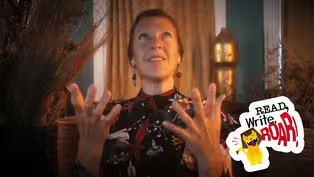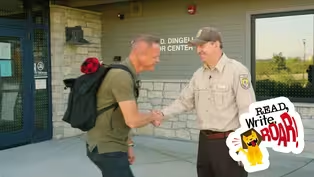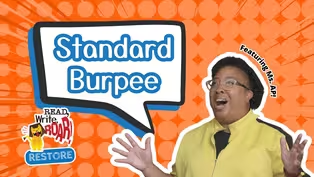Read, Write, ROAR!
Urban Sprawl Haiku: Capturing Nature vs. City Growth in Poetry | Jeff Kass | Read, Write, ROAR!
Clip: Season 1 Episode 1012 | 5m 53sVideo has Closed Captions
Learn how to capture the delicate balance between human-built cities and the natural world.
How do cities impact nature? In this video, Jeff Kass introduces the concept of urban sprawl and teaches us how to explore it through the ancient Japanese poetic form, haiku. Learn how to capture the delicate balance between human-built cities and the natural world in your writing, without worrying about syllable count. Join us in writing powerful haiku that paint vivid pictures of this intersecti
Problems playing video? | Closed Captioning Feedback
Problems playing video? | Closed Captioning Feedback
Read, Write, ROAR! is a local public television program presented by Detroit PBS
Read, Write, ROAR!
Urban Sprawl Haiku: Capturing Nature vs. City Growth in Poetry | Jeff Kass | Read, Write, ROAR!
Clip: Season 1 Episode 1012 | 5m 53sVideo has Closed Captions
How do cities impact nature? In this video, Jeff Kass introduces the concept of urban sprawl and teaches us how to explore it through the ancient Japanese poetic form, haiku. Learn how to capture the delicate balance between human-built cities and the natural world in your writing, without worrying about syllable count. Join us in writing powerful haiku that paint vivid pictures of this intersecti
Problems playing video? | Closed Captioning Feedback
How to Watch Read, Write, ROAR!
Read, Write, ROAR! is available to stream on pbs.org and the free PBS App, available on iPhone, Apple TV, Android TV, Android smartphones, Amazon Fire TV, Amazon Fire Tablet, Roku, Samsung Smart TV, and Vizio.
Providing Support for PBS.org
Learn Moreabout PBS online sponsorshipan important question in the world right now is how big do we want cities to be should we just let them grow and grow as large as possible Tokyo in Japan has 37 million people living in it that's a lot of people the bigger cities get the more they spread out into land that contains natural Wildlife buildings and Roads and parking lots appear where there used to be trees and ponds and animals when cities grow and take over a land that used to be natural it's known as urban sprawl hi everyone I'm Jeff Cass and speaking of Tokyo today we're going to explore the effects of urban sprawl in the natural world through an ancient form of Japanese poetry called Haiku you may have heard of haiku before but I want to warn you I'm probably going to explain Haiku in a way that's slightly different Haiku is a poetic form roughly 800 years old a lot of teachers say haiku is a three-line poem about nature that consists of 17 total syllables where the first line contains five syllables the second line contains seven syllables and the third line contains five syllables a syllable is a part of a word that contains a vowel sound for example the word Sunset has two syllables the first syllable is sun and it contains the short u a sound the second syllable is set and contains the short e s sound but serious writers of Hau in English say that because the music of the Japanese language is so different from the music of English if you try to use the same syllable count in English the rhythm of the poem sounds completely different than it would in Japanese as a result it doesn't make any sense to count English syllables at all what's important these serious writers of Haus is to think more about the essence or the big idea of what a high cre tries to do the essence of a high coup is to capture a small moment with an image that appeals to the five senses the image is then presented to the reader as a kind of well a gift with the hope the reader will then experience a feeling similar to what the writer felt when they wrote it William J higginson author of The Haiku handbook calls Haiku a touchstone of suggestiveness what he means by that is haiku describes a moment but how the moment feels is not described how it feels is up to the reader it's true Hau are short and they're usually but not always three lines they often explore nature but specifically what they explore is the intersection between humankind and the natural world that's why they're a good way to examine the idea of urban sprawl which is the intersection of human-built cities in the natural world let me show you some examples that a Michigan author of haiku might write on the lake Bottom a walleye Peaks into the nose of a soda bottle you see how this poem paints a picture of the intersection of humankind in the natural world in the poem something natural a walleye interacts with the beauty of the lake bottom and then something human built a soda bottle seems to intrude on the natural beauty of the world you also see how while the poem is three lines the silver will count is 5 6 8 that adds up to 19 total syllables that's perfectly fine here's another high coup Mist rises above a stand of Michigan pines and a cell phone tower can you see here how a beautiful and peaceful sight of something natural Mist Rising above pine trees appears to be interrupted by the human-made cell phone tower Can You Feel the suggestion that the technology that's supposed to make our lives easier might also have the side effect of changing the beauty of our natural environment can you also see here that the syllable pattern is seven five and then six that's absolutely okay let's look at one more where the theme is slightly different in the dumpster behind a restaurant's kitchen the glint of a raccoon's eye can you see how this poem suggest more of the natural world kind of finding its way within or adapting to the human world it's not necessarily the human built world of the restaurant intruding on the natural world of the raccoon but more of the raccoon salvaging what it can which may or may not be healthy for it when it explores the human world the syllable count here is four and then eight then seven for a total of 19 syllables and that's fine too let's have you give writing some haua try notice I didn't say haikus cuz the plural of the word Haiku is still Haiku like fish you can catch one fish or you can catch 12 fish same thing with ha coup you can write one ha coup or you can write five haou I'm challenging you to write at least three remember we're exploring the notion or the idea of urban sprawl when cities spread into the surrounding Countryside think of some images that suggest an intersection between the human-built world and the natural world you don't have to worry about counting syllables but if you like the idea of doing that go ahead just keep each ha cou short a small snapshot that suggests a feeling have fun and share your favorite Creation With a Friend see if you can Inspire them to write their own high coup
Create an Underground Soundscape | Ms. Audra | Read, Write, ROAR!
Video has Closed Captions
Clip: S1 Ep1012 | 2m 16s | Imagine worms, moles, and even growing plants as we create a soundscape beneath the earth. (2m 16s)
How to Set the Mood in Film | Ms. Kara | Read, Write, ROAR!
Video has Closed Captions
Clip: S1 Ep1012 | 4m 24s | Learn how lighting and visual elements set the mood in film. (4m 24s)
International Wildlife Refuge | How to Compare Habitats | Mr. Peterson | Read, Write, ROAR!
Video has Closed Captions
Clip: S1 Ep1012 | 6m 29s | Learn how to conduct research and understand the importance of protecting wildlife. (6m 29s)
Read, Write, ROAR! Restore - Standard Burpee
Video has Closed Captions
Clip: S1 Ep1012 | 2m 33s | Warm up, add new moves to your burpees, and cool down to stay energized throughout the day. (2m 33s)
Providing Support for PBS.org
Learn Moreabout PBS online sponsorship

- Home and How To

Hit the road in a classic car for a tour through Great Britain with two antiques experts.












Support for PBS provided by:
Read, Write, ROAR! is a local public television program presented by Detroit PBS




